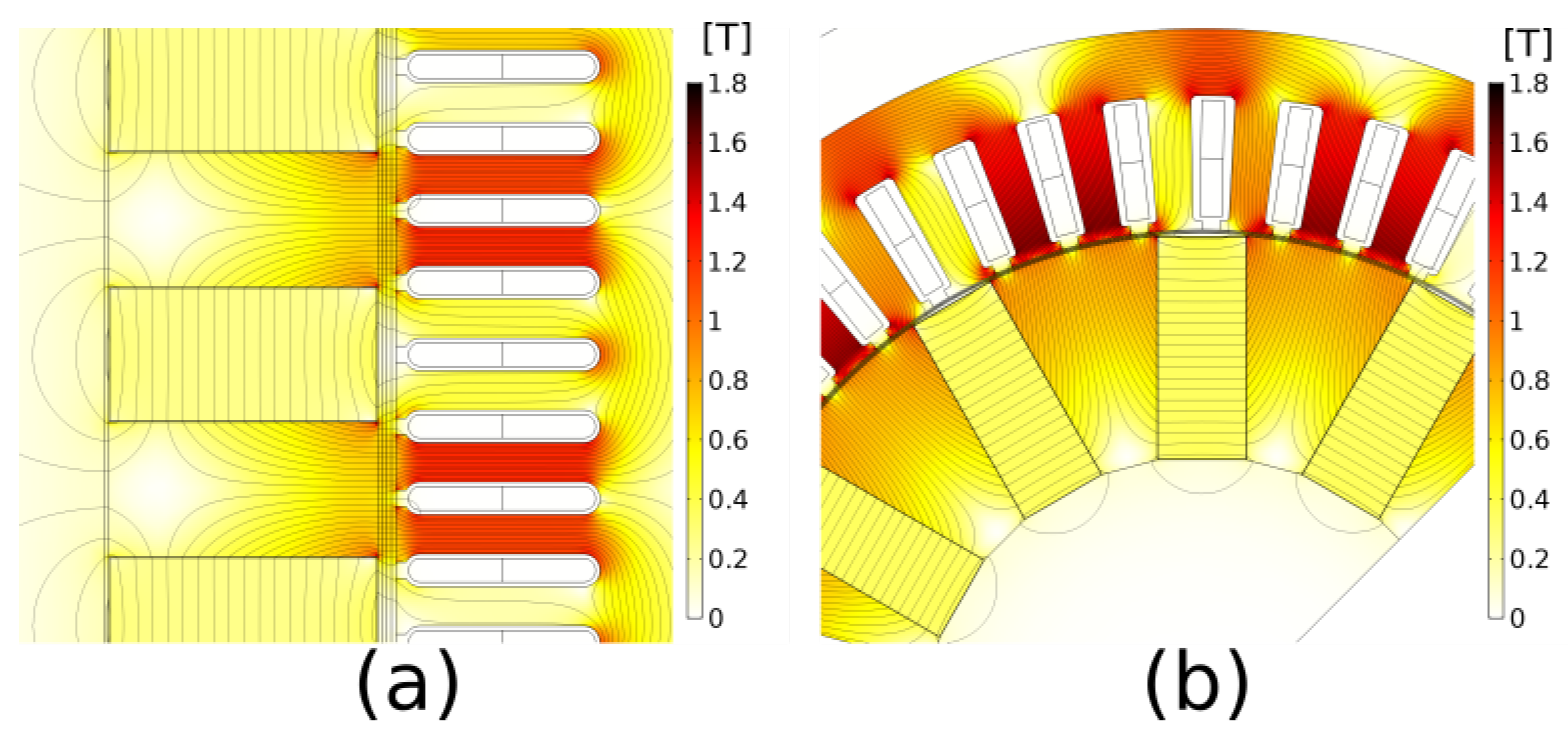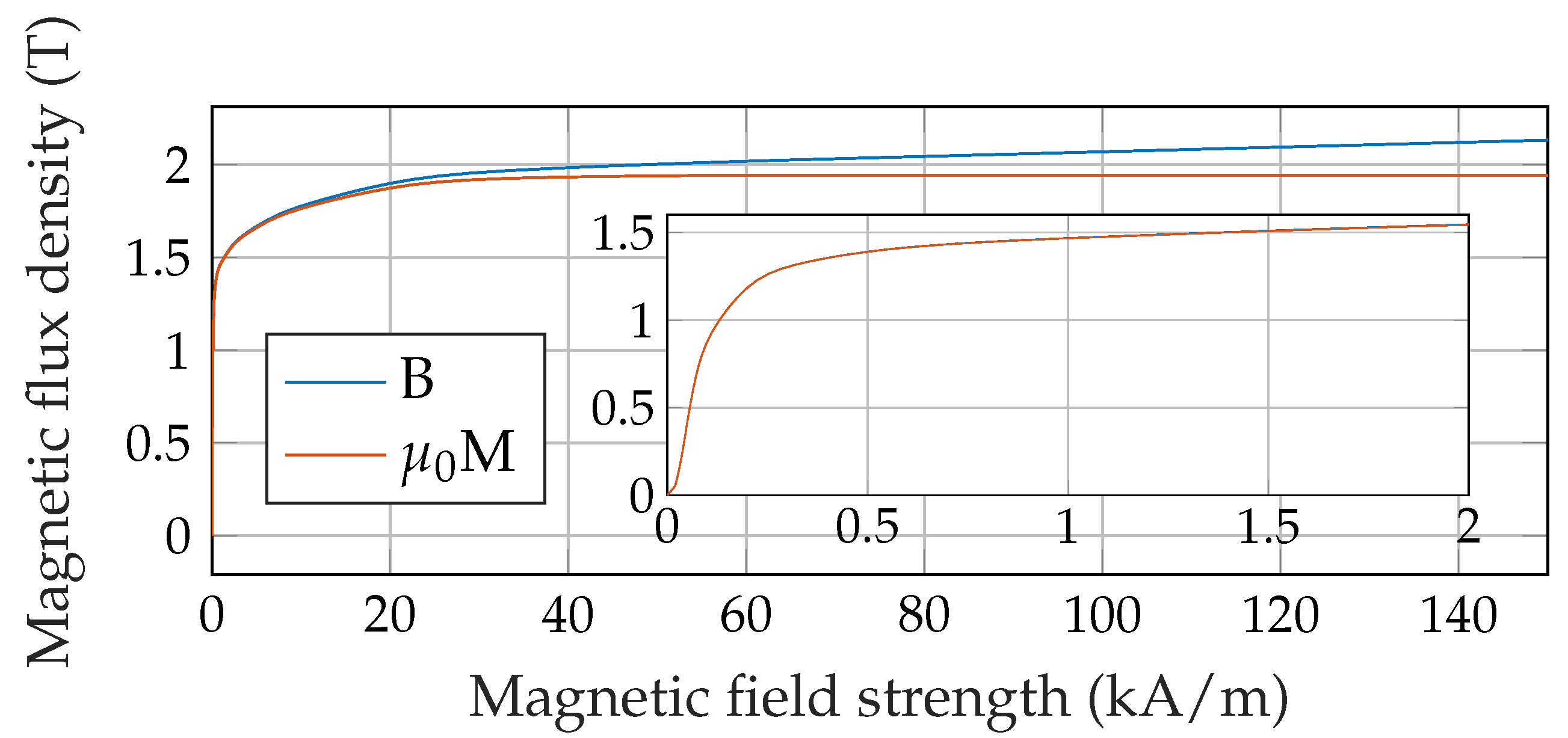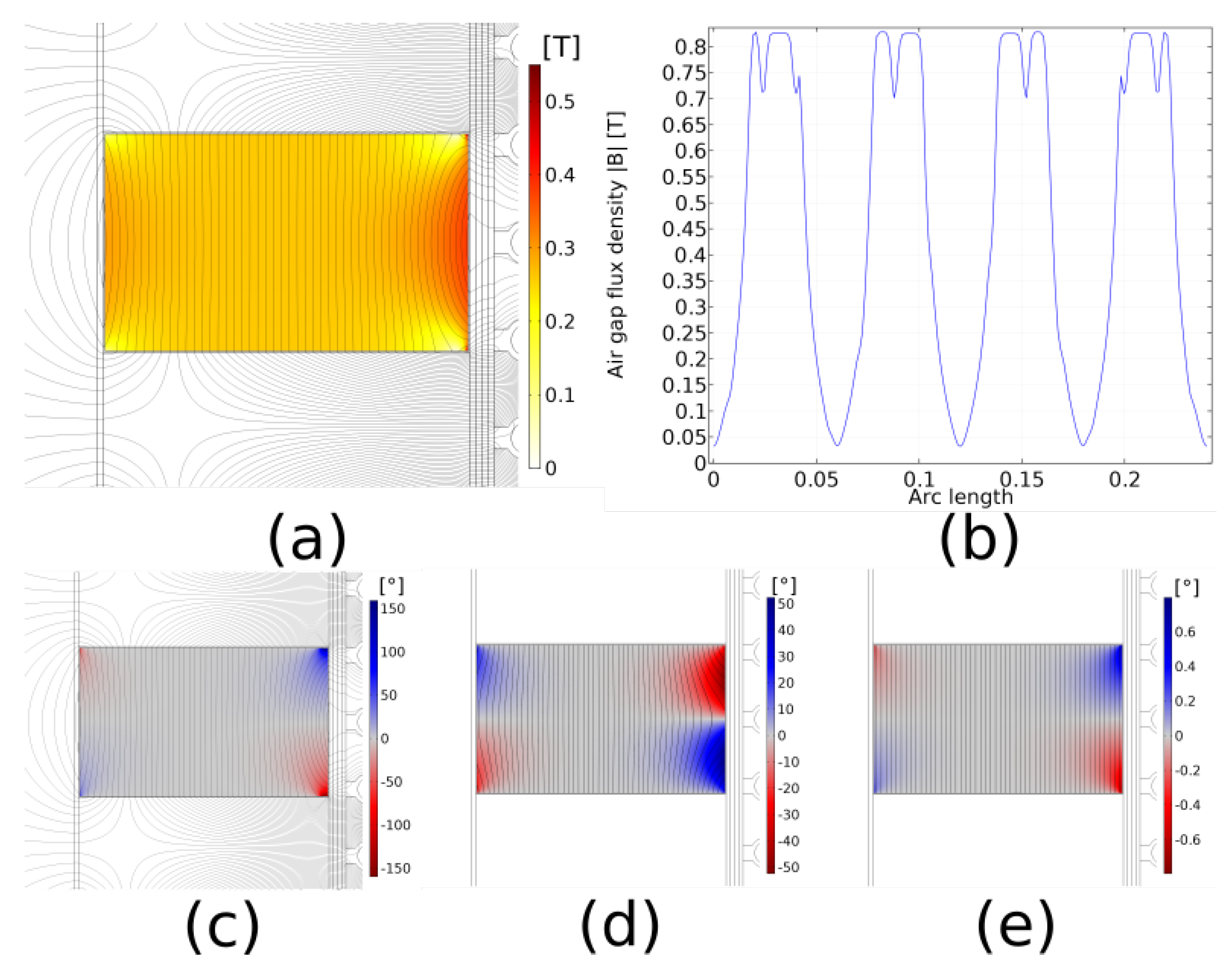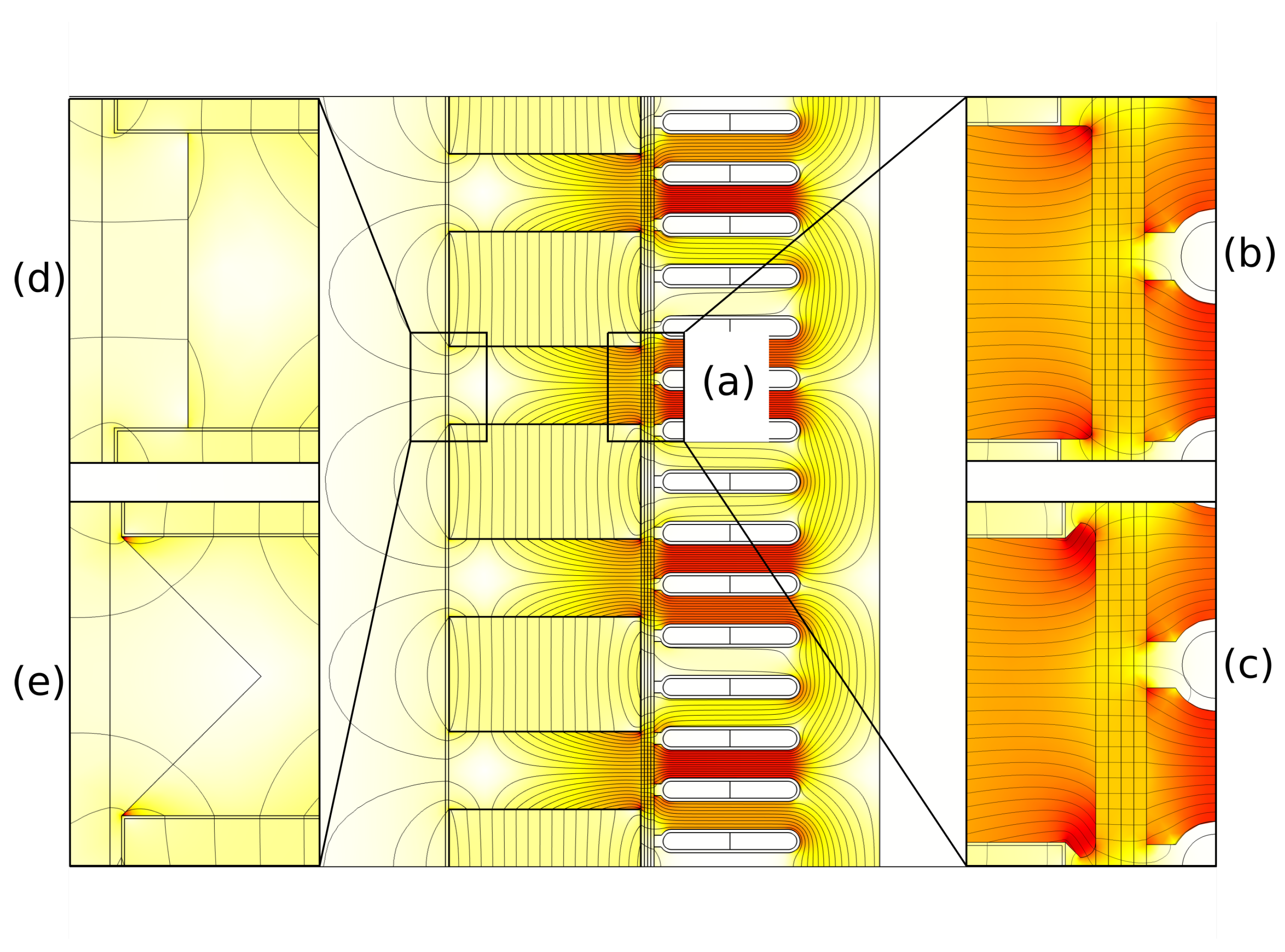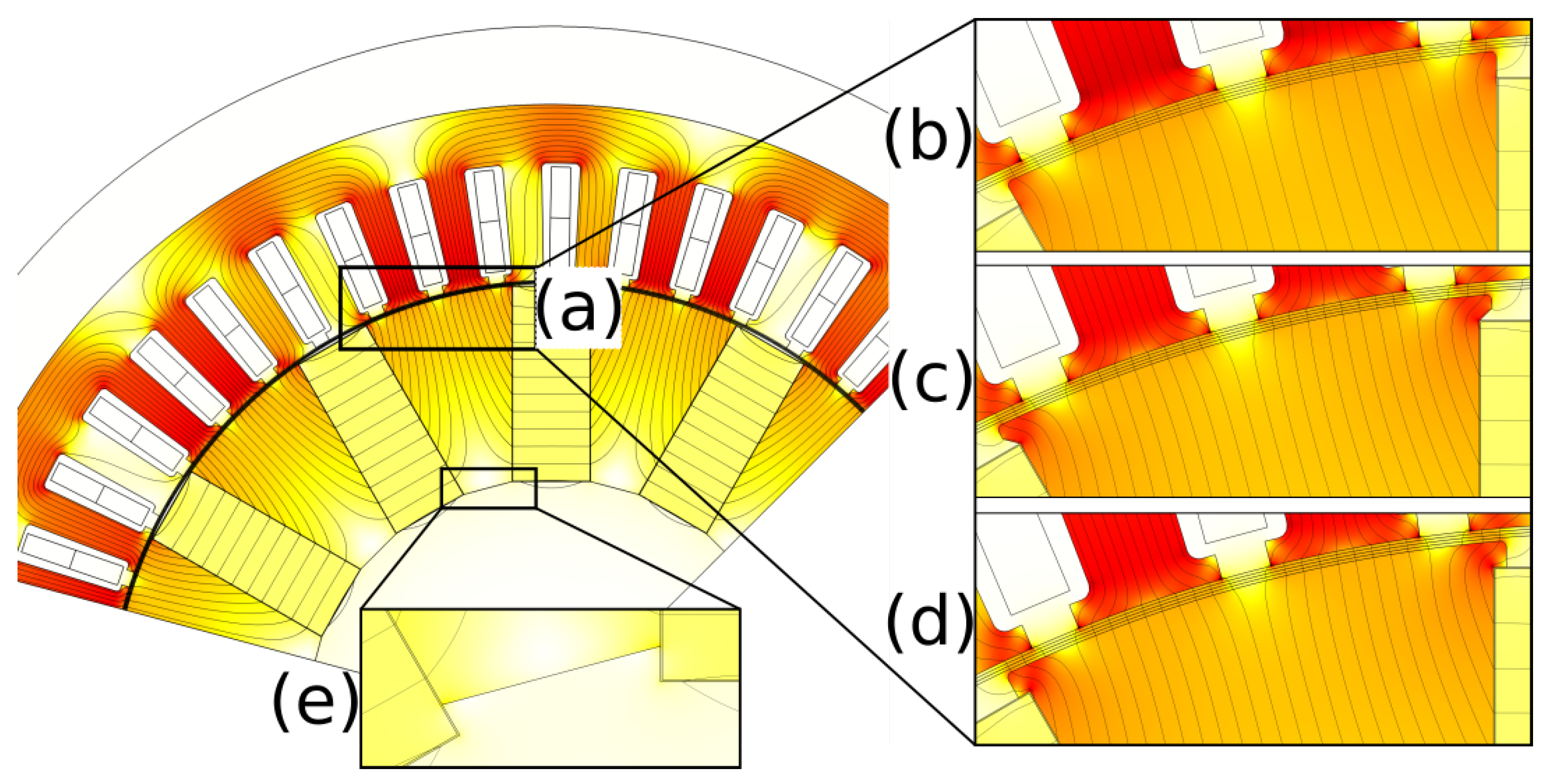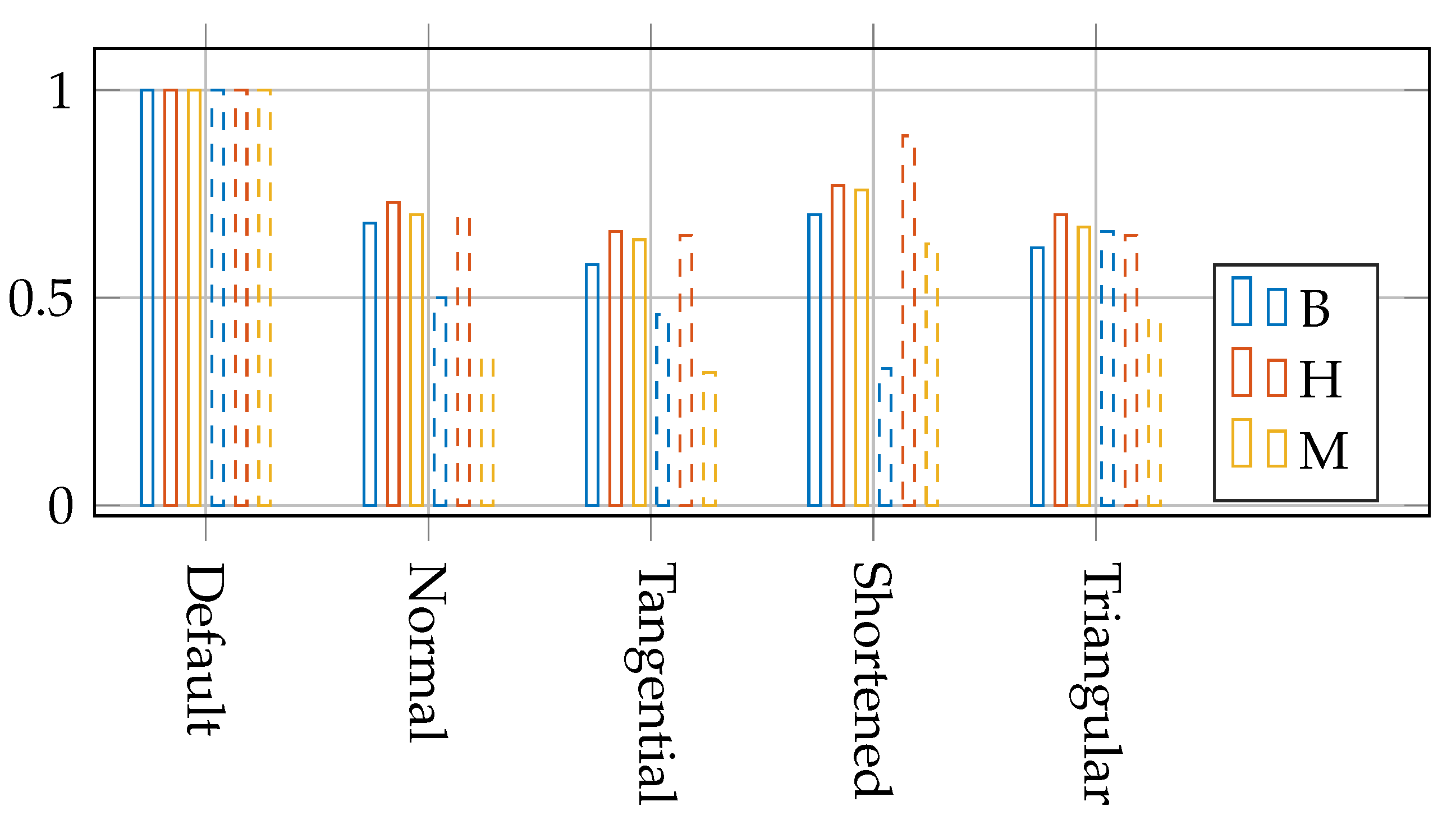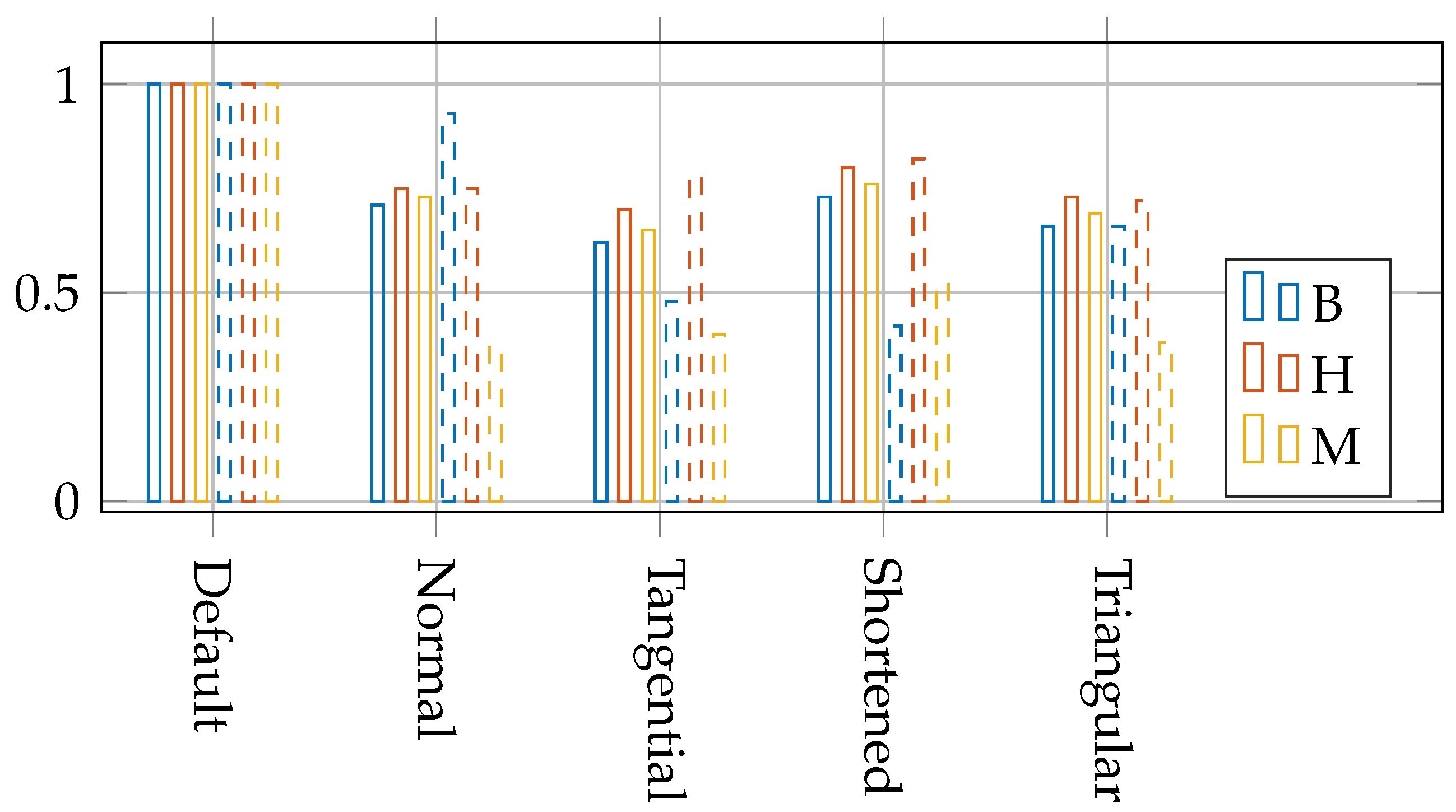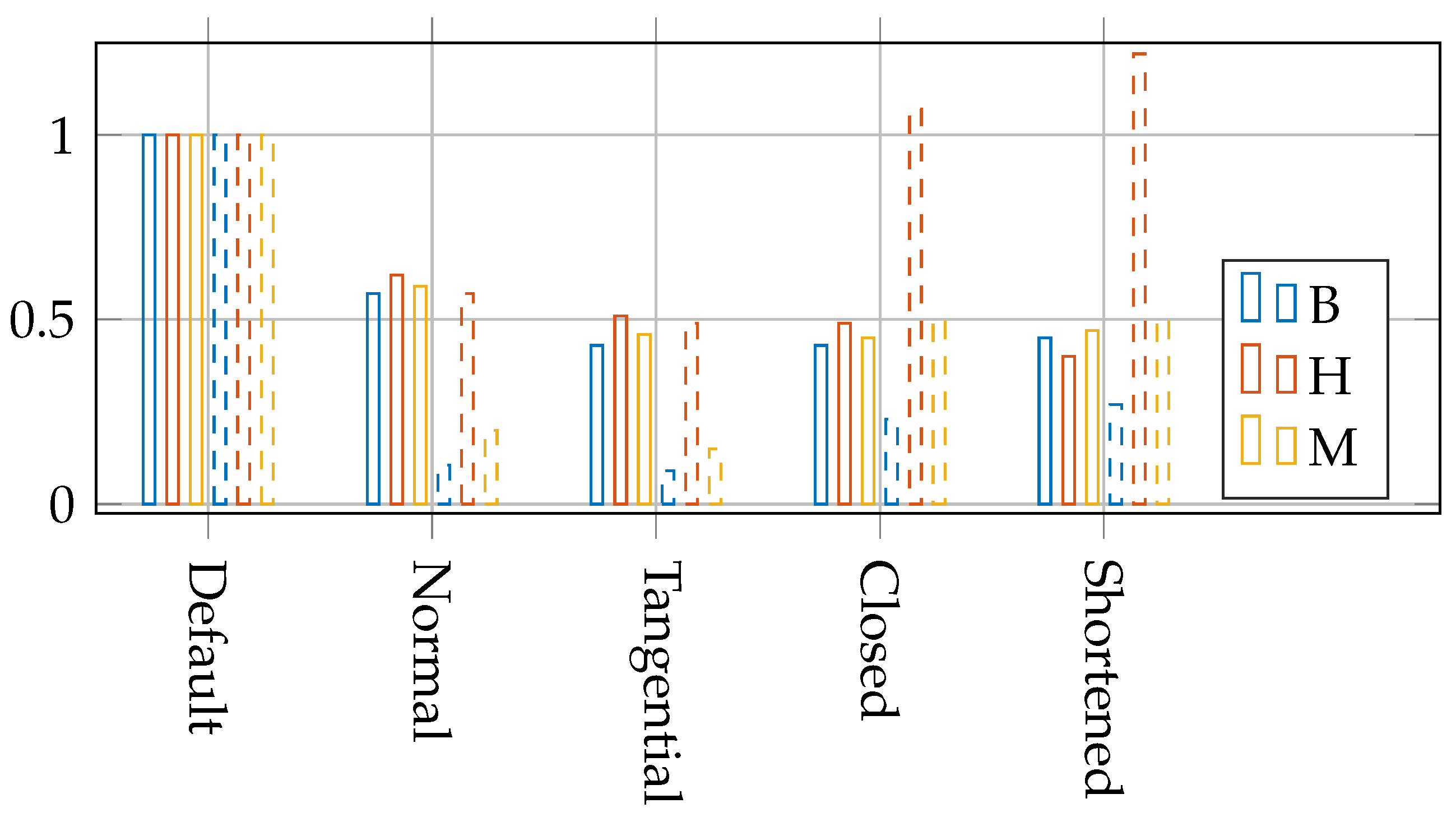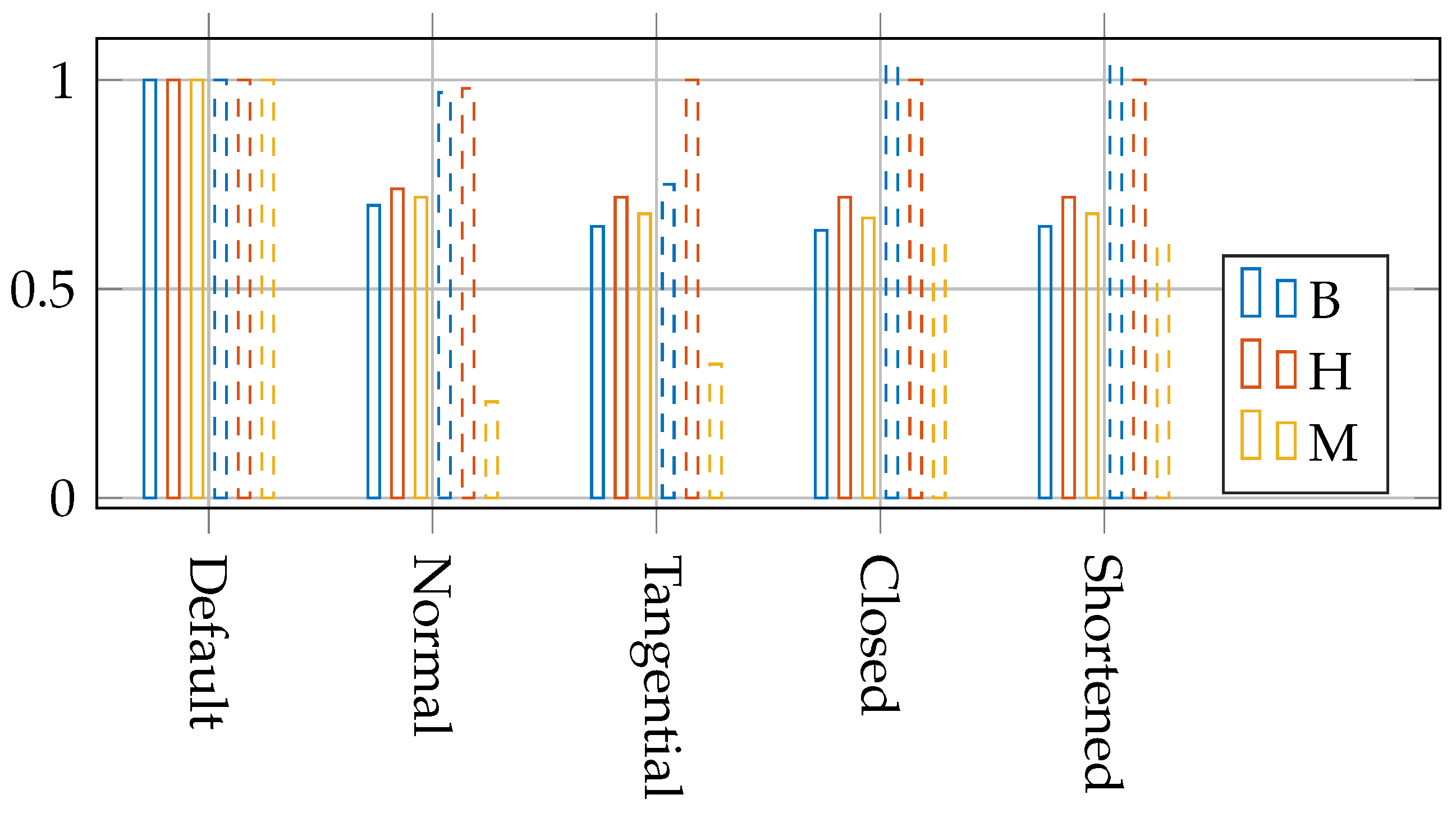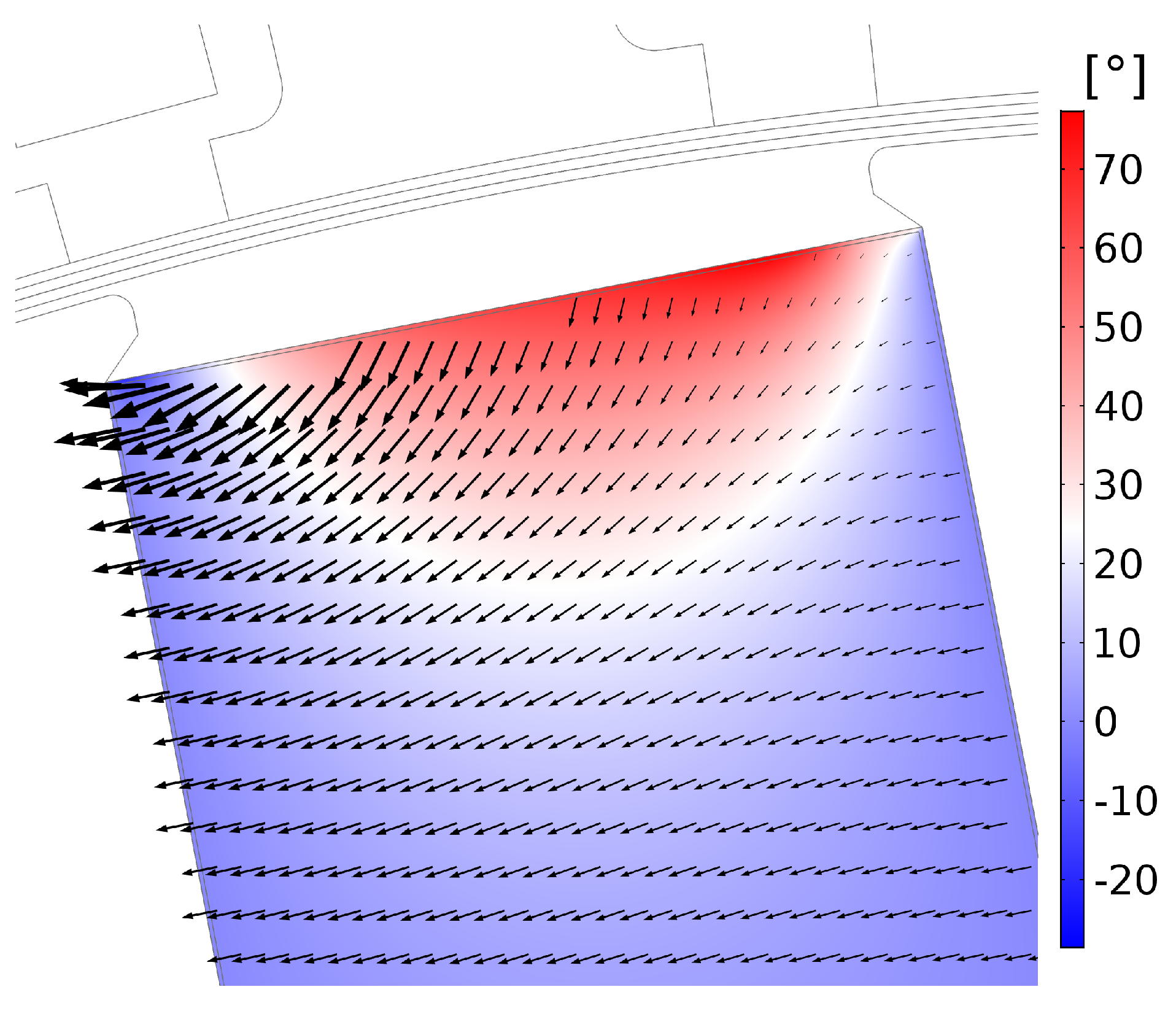The equation describes the interaction between the magnetic moments of the magnetization and the environment the magnetic material is placed in, both through the self-demagnetizing field strength and external currents included in the applied magnetic field strength .
The relative permeability describes how the magnetization of the material changes with the magnetic field strength H. The relative permeability can further be expressed by , where describes the proportionality between changes in H and M, where .
In a magnetic material, governed by (
1), the presence of the magnetization will cause the three quantities B, H and M to be in different directions. Ideally, the magnetic flux density will be in a similar direction to the magnetization and the magnetic field strength will be in the opposite direction, but all will have some inclination. To allow for the inclined fields, where (
2) can no longer be described as a 1-D system, the permeability
can be described as a tensor. The presence of a perpendicular magnetic field strength will cause a change in the perpendicular magnetization following the perpendicular element of the permeability tensor. In the model used here, the permeability is defined as a scalar. This means that any changes in the magnetic field strength will cause changes in the magnetization of the same magnitude in the perpendicular direction. The perpendicular permeability can, however, exceed the parallel component for ferrite PMs [
12]. The purpose of this paper is to study the general trends of the inclination angles and the presented results should be sufficient to draw general conclusions.
2.1. Simulations
In the model, the remanent flux density and thus the remanent magnetization are assumed to be uniform in the buried direction of the magnets. This means that
and
at zero magnetic field strength, where
according to (
1). The magnetic flux density
B is divergence-free due to
from Maxwell’s equations (Gauss’s magnetic law). This allows for the formulation for the magnetic vector potential
. Using the magnetic vector potential
, the contour lines of
A will describe the field lines of the magnetic flux density
B.
The winding pattern used in the simulations is the fractional pattern of
. The fractional winding pattern reduces the cogging forces that are otherwise higher for an integer number winding pattern and the winding pattern of
still allows for periodicity after only two pole pairs, if two phases can be wound in the same stator slot. The periodicity can be implemented by mapping the magnetic vector potential
A between both periodic ends [
13].
The simulations are computed in a finite-element software called COMSOL Multiphysics (COMSOL Multiphysics is a registered trademark of COMSOL AB). They are done in a 2-dimensional environment for both the linear machine and rotating machine. A rotating electrical machine module is used for the rotating machine, which can take advantage of the closed rotor and the boundary between stator and rotor by introducing a sector symmetry condition. The sector symmetry allows the machine to be split into a smaller computational space for a minimal periodicity. A Magnetic field module is used to simulate the magnetic circuit of the linear model. Similar to the rotating machine, the smalllest periodicity is used, made up of 15 slots and two pole pairs.
The starting point of the simulations for the buried topology is permanent magnets of rectangular blocks, where the pole shoes are extruded along the outer boundaries of the rectangular PMs. In a rotating machine, the pole shoes will arc in a circular pattern between the PMs while, in a linear machine, the pole shoes will be bound by linear lines. These are illustrated in
Figure 1a,b, respectively, and are denoted the
default cases. The parameter settings used for the respective machine are further detailed in
Table 1.
As can be seen in the table, the parameters for the linear and rotating electrical machines differ as intended, due to the different applications. The phase currents are controlled by setting the currents in-phase with the no-load voltage. This implies that the phase angle and load angle coincide, which further sets the direct current to zero. The reason for this is that the current can directly be based on the phase angle of the induced voltage, without the need to consider the terminal voltage. This can reduce the computational time remarkably and ease the convergence of the simulation. The currents are set in the q-axis of a moving reference frame and the current directions are determined based on the application: generator drive for the linear machine and motor drive for the rotating machine. In the simulations, Silicon Steel Non Grain Oriented (NGO) 50PN270 is used for the soft magnetic materials of both translator/rotor and stator. The soft magnetic material is illustrated in
Figure 2. Eddy currents and hysteresis losses in the soft magnetic materials are neglected.
The inclination angles and magnitudes associated with the no-load default case can be seen in
Figure 3.
From the figure of the no-load operation, several behaviours can be seen. In
Figure 3a, the flux density is plotted. Due to the pole shoe ending at the boundary of the PMs, with no extrusion towards the air gap, the magnetic flux density is forced to change direction rapidly at the boundary between PM and pole shoe. From
Figure 3b, one can see that the flux distribution is different for different stator teeth. This is due to the fractional number of slots per pole and phase. In
Figure 3c, one can see that, due to the rapid change in the flux density at the boundary, some of the flux density points in the negative direction.
Figure 3d and
Figure 3e show the inclination angle for the magnetic field strength and magnetization, respectively. The inclination angle of the magnetic field strength is opposite due to the negative value of the self-demagnetizing field.
The averaged and maximum absolute inclination angles are further detailed in
Table 2.
The magnetic flux density is continuous on the boundary between materials with different magnetic properties. The magnetization and magnetic field strength do not, however, share the same attribute. To achieve a continuous domain for the magnetization and magnetic field strength, an inner domain for the PM material is introduced. The inner domain covers 99% of the PM in the magnetization direction and should enhance the credibility of the tabulated values for the PM domain. The averaged magnitudes of the magnetic flux density in the air gap and the RMS induced voltages are also tabulated.
Similarly, the results for the rotating machine can be seen in
Table 3. Due to the high current density, the inclination angles are increased substantially. The inclination angle is further influenced by the highly saturated stator steel, which is evident by the lack of increased air gap flux density for the load case.
The difference in saturation level between the two topologies and applications is further visualized in
Figure 4. The current density of
for the linear case has little impact on local saturation compared to the no-load case in
Figure 1. What can be seen, however, is the slight inclination in the magnetic flux, indicated by the higher flux density on the upper slot for a specific pole. The impact of
for the rotating case is more severe, since the stator teeth and pole facing in the direction of the inclined magnetic flux become highly saturated. As the saturation level increases, the soft magnetic material will act more as a material with low permeability, and the flux will be less prone to passing through the soft magnetic material. Instead, an increased amount of flux will pass directly from the stator tooth, through the air gap and into the upper boundary of the PM.
The increased current density of the rotating machine sets higher demands on the implementation of inclined field behaviour. In
Figure 5, different current densities are visualized for the default case without extrusions. The inclination angle of the no-load case in (a) are rather symmetric along the magnetization direction, but as the current density increases from (b) to (d), the inclination angle of the magnetic field strength increases, as well as the asymmetry.
An explanation of the high inclination angles of the magnetic field strength can be found through the origin of Ampere’s law, , where the magnetic field strength caused by the high current density acts against the negative magnetic field strength within the permanent magnets close to the borders of the PM in the proximity of certain regions of the air gap.
